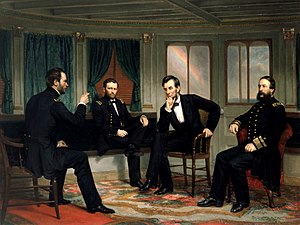The Peacemakers
| The Peacemakers | |
|---|---|
 | |
| Artist | George P.A. Healy |
| Year | 1868 |
| Medium | Oil on canvas |
| Dimensions | 119.7 cm × 159.1 cm ( 471⁄8 in × 625⁄8 in) |
| Location | White House, Washington D.C. |
The Peacemakers is an 1868 painting by George P.A. Healy. It depicts the historic March 28, 1865, strategy session by the Union high command on the steamer River Queen during the final days of the American Civil War.[1]
Contents
[hide]Historical setting[edit]
In March 1865, General-in-Chief Ulysses S. Grant invited President Lincoln to visit his headquarters at City Point, Virginia. By coincidence, Major General William Tecumseh Sherman (then campaigning in North Carolina) happened to visit City Point at the same time. This allowed for the war's only three-way meeting of President Lincoln, General Grant, and General Sherman.[2] Also present was Rear Admiral David Dixon Porter, who wrote about the meeting in his journal, and later recounted:
Painting[edit]
General Sherman's recollection[edit]
The artist was not present at the meeting near Richmond. However, he had previously painted individual portraits of the four men and he had obtained the data from which he worked from General Sherman.[4] In a November 28, 1872 letter to Isaac Newton Arnold, General Sherman wrote:
Fate of original painting[edit]
The original version of the painting was destroyed by the Calumet club fire in 1893.[6] A second copy was discovered in 1922, after lying unnoticed in a family storeroom in Chicago for fifty years.[7] The acquisition of the painting by the Truman White House in 1947 was laden with contemporary significance, for another great conflict, World War II, had ended just two years earlier.
Legacy[edit]
The pose of Lincoln inspired Healy's 1869 portrait, Abraham Lincoln. Robert Todd Lincoln considered the likeness of his father in this painting to be the "most excellent in existence."[8]
Yet perhaps nowhere do we learn more about Lincoln even now than in a portrait that I talked about last month off the coast of Malta before meeting Chairman Gorbachev. It is, as this one is, by George Healy, and hangs on the wall of my office upstairs. And in it you see the agony and the greatness of a man who nightly fell on his knees to ask the help of God. The painting shows two of his generals and an admiral meeting near the end of a war that pitted brother against brother. And outside at the moment a battle rages. And yet what we see in the distance is a rainbow—a symbol of hope, of the passing of the storm. The painting's name: The Peacemakers. And for me, this is a constant reassurance that the cause of peace will triumph and that ours can be the future that Lincoln gave his life for: a future free of both tyranny and fear.
“
”
The U.S. Postal Service commemorated the 200th anniversary of the birth of Abraham Lincoln by issuing four first-class commemorative 42-cent stamps. One of these stamps features an image of this painting.[9]
The painting was displayed in the Treaty Room of the White Housefrom the Kennedy through the George W. Bush presidencies. In his book Decision Points, President Bush mentions the painting specifically and makes the following comment: "Before 9/11, I saw the scene as a fascinating moment in history. After the attack, it took a deeper meaning. The painting reminded me of Lincoln's clarity of purpose: he waged war for a necessary and noble cause." It was briefly loaned to the George H. W. Bush Presidential Library from March 11, 2002 to July 31, 2002 for an exhibit entitled, "Fathers and Sons: Two Families, Four Presidents."[10] The painting is also featured behind the elder Bush in his official presidential portrait, painted by Herbert Abrams.
The Obama administration moved the painting to the private President's Dining Room, where it currently hangs.[11] There is also a copy of the painting at the Pentagon.[12]
See also[edit]
- Military leadership in the American Civil War
- End of the Civil War 1864-1865
- Carolinas Campaign
- Military art
References[edit]
- ^ Kloss, William; Koreen Bolger (1992) [1992]. Art in the White House: a nation's pride. White House Historical Association in cooperation with the National Geographic Society. p. 156. ISBN 978-0-8109-3965-3.
- ^ Sherman, Memoirs, pp. 806-17; Donald C. Pfanz, The Petersburg Campaign: Abraham Lincoln at City Point (Lynchburg, VA, 1989), 1-2, 24-29, 94-95.
- ^ Porter, David Dixon (1886) [1886]. Incidents and anecdotes of the Civil War. D. Appleton and co. pp. 313–317. Retrieved 2010-01-02.
- ^ Truman, Harry (1947-02-13). "31 - The President's News Conference". The American Presidency Project. Archived from the original on 2008-11-28. Retrieved2010-01-02.
- ^ Arnold, Isaac Newton (1885). The life of Abraham Lincoln. Chicago, IL: Jansen, McClurg, & Company. p. 423. Retrieved 2010-01-02.
- ^ "Valuable Cannot Be Replaced". Chicago Daily Tribune. 19 Jan 1893. p. 6.Archived from the original on 26 September 2015. Retrieved 30 August 2015 – viaNewspapers.com.

- ^ Moffat, W.D., ed. (1922-01-02). "Eighteen Days Before Lincoln Died". The mentor-world traveler. Springfield, OH: The Crowell Publishing Co. 10 (1): 46. Retrieved2010-01-02.
- ^ Ulrich, Bartow Adolphus (1920) [1920]. Abraham Lincoln and Constitutional Government. 3. Chicago, IL: Chicago Legal News. p. 251. Retrieved 2010-01-02.
- ^ Saunders, Mark (2009-09-02). "USPS News - Lincoln's Life Chronicled on Stamps". United States Postal Service. Archived from the original on 2009-12-30. Retrieved 2010-04-29.
- ^ "http://bushlibrary.tamu.edu/exhibits/2002-fathers_and_sons/". George Bush Presidential Library and Museum. Archived from the original on 8 January 2013. Retrieved 26 September 2012. External link in
|title=(help) - ^ Rozen, Laura (2009-11-15). "In W.H., are pictures telling a story?". Arlington, VA: Politico. Archived from the original on 2009-12-20. Retrieved 2010-01-31.
- ^ John T. Woolley and Gerhard Peters, The American Presidency Project [online]. Santa Barbara, CA. Available from World Wide Web: "Archived copy". Archivedfrom the original on 2012-09-21. Retrieved 2010-02-01..


No comments:
Post a Comment